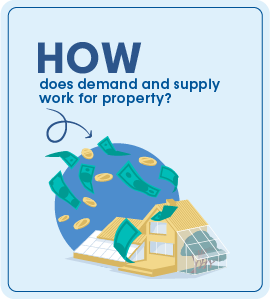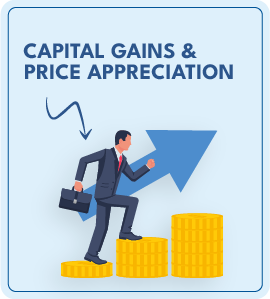Investing Guide
How do property prices increase

Real estate and property seem to be an obvious and non-brainer choice for anyone looking to invest their money. But all properties are not equal and hence the returns on each will differ significantly. In order to understand if buying a certain property will deliver significant capital gain or price appreciation, you must first understand what drives the prices up or drags the prices down. Then you will need to evaluate how these principles will work for the property you intend to acquire.
The prices of all properties, like any other commodity, depend solely on the demand and supply principle. To put it simply, abundance drags prices lower and scarcity drives prices higher i.e.:
- Greater the supply, lower the prices
- Lower the demand, lower the prices
- Greater the demand, higher the prices
- Lower/ limited the supply, higher the prices
Greater the supply, lower the price

The greater supply of things like common salt and sand etc. are responsible for their low prices. Their wide availability also prohibits their accumulation by individuals and organizations since they cannot expect to sell it at higher prices at a later stage. Likewise, if an agricultural state produces more product than it requires; the prices will be lower.
Lower the demand, lower the price

Greater the demand, higher the price
If a region or country produces a certain product for which there is no domestic demand, the prices will be automatically lower. Consider the prices of say shrimps in Pakistan. While it is not to say that people do not like or eat this particular seafood in our country; it is reasonable to argue that it is not as popular as say meat, chicken or fish etc. The same product (shrimp) would yield much higher prices for the local fishermen abroad where it is in demand. But domestically, it will have a lower price.
Lower the supply, higher the price
With most trendy and fashionable things, the producers cannot keep up with the demands and fall short on supply side. Consequently, the prices rise since it becomes a more sought-after commodity. This is also applicable in case of companies with a limited market cap and producing reasonable profits for its shareholders. Or consider the limited editions of a product launched by a certain company.

The classic case of limited supply cases would be precious natural items like gold, silver, and other rare earth metals. Their total quantity on the planet is predetermined. These are not going to increase or decrease. As more people possess the money and desire to buy these materials (increase in demand), the available remainder of sellable shrinks and hence the price increases. A digital and 21st century example would be that of Bitcoin where the maximum number of coins are predetermined and as people see it as a valuable asset and buy more of it, the worth of more limited available remainder increases.
Conclusion
All these principles apply in real estate as well. The moment a new project is made available for sale; potential buyers evaluate its worth against the set price and decide to buy – or not. Greater investment interest in a project establishes trust in the project and the remainder becomes even more sought after and pricey. It is also governed by the progress of development and later occupancy rate. Both reflect the credibility of project and greater number of people become willing to be a part of the project – even at higher prices.
Conversely, if a project presents lower value for money (consequently lower sales/investments), displays poor development progress, and occupancy rate; the demand for such project reduces and the prices either go down or stay stagnant for a long time.









